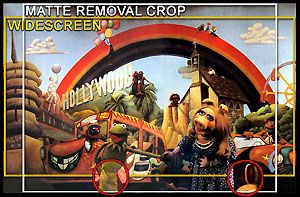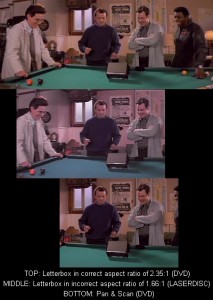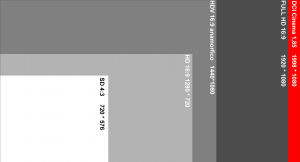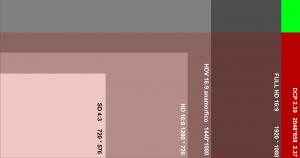After reading so much misinformation on forums and books, I felt like writing something to clarify some concepts that should be commonplace for those who work in video, but often are not.
The aspect ratio
The aspect ratio is the ratio of height to width of images, which in film and TV have changed over time both to provide more exciting images and in the race of competition between film and TV.
Now I am not going to give you the history of aspect ratio, partly because there is this wonderful documentary on vimeo that shows all the evolutions of the various film and TV formats.
The Changing Shape of Cinema: The History of Aspect Ratio from FilmmakerIQ.com on Vimeo.
At widescreen.org you will find all the variations that have arisen over the years of film formats.
When we make a movie there are rules, so we can’t invent anything, because if we go outside the rules we can’t distribute the movies.
Blurays have standards both in terms of frames per second and in terms of the size of the movie, which will always and still be with a ratio called 16:9, so with an aspect ratio of 1.78.
If you want to produce a bluray with a different format you will put the classic black bands on the top and bottom, because the standard is defined and therefore you cannot put in formats other than the standard: 1920 x 1080 at 24 progressive frames, that is, like cinema.
There are variations with the 25 interlaced and others, but if you want to make a product for cinema and TV, you stay in the 24 progressive.
So if a film has a different aspect ratio, it will contain black bands in the bluray to achieve the correct video file size of 1920 x 1080.
In digital cinema, the DCP (Digital Cinema Package) format has different aspect ratios ranging from the classic 1.85 to the cinema scope 2.39 , and have different pixel height-width ratios.
Format 1.85 : 1998×1080 pixels or double their size, for 4K projection
Format 2.39 : 2048× 858 pixels or double them, for 4K projection
In cinema there is no concept of black bands, at most there are projector masks. In film shooting, a good DOP has several indications in the viewfinder that tell it where the frame will be cut for film projection, for television viewing (4:3 and 16:9), and so on.
Pan and Scan
In the past depending on the viewing and projection formats they would put on the film pizza the indication of the aspect ratio, the eventual anamorphic lens to be mounted, because in the projection stage, the projectionist would put a stencil in front of the projector to have the correct aspect ratio. This is because in the shot, microphones could come into the field, pieces of the special effects could be seen, and so on–so with the stencil, such elements were hidden. In this image from the Muppet movie, you could see the edges of the stencil, the animators’ hands, and more…
This is because in the shot, microphones could come into the field, pieces of the special effects could be seen, and so on–so with the stencil, such elements were hidden. In this image from the Muppet movie, you could see the edges of the stencil, the animators’ hands, and more…
In the early days of television and home video pouring there were big problems, from the infamous pan and scan, which basically cut the images sideways so that the black bands would not show, butchering the films, or they would film completely but not put masking, so in some films you could see flaws and problems not present in the film version, for example in Total Recall with Arnold Schwarzenegger, in the finale you could see the supports holding up the mars backgrounds, or in Don’t Look at Me I Can’t Hear You, in a scene where a car runs uncontrolled down a hill you can see the hook and part of the camera car that was used to move the car under the control of the stuntmen…
 On the Theraffon.net website we find a nice example image of how the GhostbustersII film was repeatedly raped by reframing for homevideo and laserdisk and DVD versions.
On the Theraffon.net website we find a nice example image of how the GhostbustersII film was repeatedly raped by reframing for homevideo and laserdisk and DVD versions.
Starting from the cinematic original to the different variants of cutting and manipulation of the original framing.
We see how key characters (two of the main characters) are lost depending on the formats.
This problem is unfortunately still present in the various adaptation systems of digital televisions that in the ill purpose of eliminating black bands, distort, cut and manipulate the original images betraying the original spirit of the framing created in the film.
Digital today, easy solution?
Today with digital at the cinema IN THEORY it is easier, but you see many cinemas where they set the wrong projection format believing that all films are in cinemascope by cutting off the images above and below (in dialogues heads remain cut off, in advertisements many writings are off-screen).
In short, today we are fortunate enough to be able to repeat in a multiplex with a digital projector, the vintage experience we had in theaters 4 category 50 years ago…
How to set the framing for different aspect ratios?
If we want to make a movie that will then have to be adapted to the 1.85 wide-screen format or the 2.39 cinema scope, the simplest thing is to take an acetate panel and draw lines on it to highlight the visual limitations from those formats, so that by placing the acetate panel over the camera’s lcd viewer, or on the control monitor, we can get an idea of how to build the framing for that format.
It is very important to decide at the shooting stage on this division, because the balance and quality of the framing is decided at that moment, afterwards we will not be able to adjust the framing except slightly and thus we will lose professionalism instead of increasing the cinema effect.
Two dispassionate suggestions for the shooting phase :
– always keep 5-10% wider than what you consider the final shot, any stabilization work and slight re-framing (cropping of the frame) could create imbalance if you have not left air around your shot.
– however, consider the framing as total, even if you then remove something above and below, because if you were forced to move the image up or down to adjust the framing, any spurious elements in the frame that you consider cropped will prevent this movement, or force you to delete it.
I enclose this pair of PNGs in which I have put the images of the two most commonly used film formats in comparison with the different video formats, just to understand how at the pixel count level there are no particular differences, so a good-very good fullHD can be used to make a more than decent film DCP, especially considering that for 50 years many films were shot in 16mm and blown up to 35mm, or used 35 very stretched.
In the next article we will talk about pixels in shooting, in compression, why not all FullHD is the same, and most FullHD movies are “fake” meaning that even though they have that number of pixels, they do not contain an equal amount of information to what you would expect, so FullHD is not always Full… in fact…




Leave a Reply
You must be logged in to post a comment.